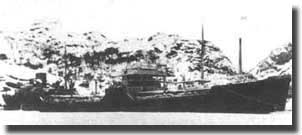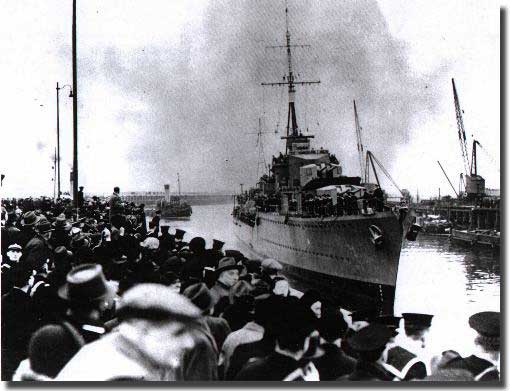|
The Navy's HERE . Rescue of 300 British POW's From Altmark. February 1940.
Altmark had acted as a tanker and supply ship for the German battleship Graf Spee, during her raiding cruise in the South Atlantic. British ships had accounted for this raider at the Battle of the River Plate, embarked in Altmark were a number of crews from British ships which had been sunk by the German battleship. Altmark had managed to elude patrols and passing between Iceland and the Faroe Islands had arrived at Trondheim on the 14th. of February 1940. Once there, she needed to decide whether to make her way south, outside or inside Norwegian territorial waters, if she stayed inside, strictly speaking, her Prisoners of War would be entitled to be released, since these were neutral waters. Not worrying about any convention, Altmark proceeded inside Norwegian waters.
Altmark, both a German Raider supply ship, British Naval Force. They found nothing, the next day, the Admiralty received a signal indicating that the armed German supply ship Altmark, carrying 300 British POW's on board had passed Bergen at noon, her guns removed she looked like an innocent tanker. C-in-C Home Fleet signals Cossack Force.
Cossack and her consorts sailed north, at Noon on the 16th. of February aircraft reports gave differing positions, and it seemed that different ships were being both sighted and then reported as Altmark. The ships were divided up, Arethusa with Intrepid and Ivanhoe, were sent off to scour a Northward Zone and Cossack, Maori and Sikh searched away to the south. Frustration for the southern group, after a stern chase their quarry proved to be a Swedish ship, and despite a flood of aircraft reports, no one had actually sighted the wanted vessel. No firm information was held on board concerning the ship they were seeking, the only real clue, a picture of two ships in a Wardroom copy of the Illustrated London News, the caption read:
The text under these two ships did not indicate which one was Altmark, and it was assumed the the four masted ship in the foreground , rather than the tanker type ship further away, was the one wanted. Thus when a freighter with four masts was found it was thought to be Altmark, not so, it was the tanker type ship that was the actual one that the force should be hunting. Officer in Arethusa comes to the rescue. The Admiralty had signalled interception should be made in neutral waters, Captain Q. D. Graham in Arethusa, sent in his destroyers, but Altmark ignored orders to stop. There were two Norwegian torpedo boats shepherding the German ship, keeping the British destroyers from boarding. Now level with Josing Fiord, Altmark turned hard to port, increased speed, and dashed through the narrow entrance, the Norwegians closed in quickly behind her, blocking off the channel. Darkness fell as Cossack arrived, should there be no prisoners on board the German ship, then the Norwegian Torpedo boats had acted quite correctly, but, and it was a huge but, were there any British POW's aboard? British R.N.V.R. Officer takes the initiative. Absolute deadlock!!
The gist of this message was passed to the Norwegian officer, who was not moved by that argument. He was now told in no uncertain terms that time was important, we did not want German aircraft to intervene come daylight, Cossack was in a position to use her pom-poms on the Norwegian decks, whilst her torpedo tubes did not menace the British detroyer. Craven said that we would talk no longer, and were going to board and search Altmark, whether we had to fight the Norwegians or not. At this stage the Captain of Kjell, decided he could withdraw with honour, and did so. Altmark, came into view as Cossack steamed round a bend, her bows pointing inshore and covered in ice, against the snow covered mountains her stark black bulk made a striking contrast. The Captain of Altmark was not giving up easily, he came charging astern through the channel his passage through the ice had made, his searchlight trained on the destroyer's bridge to blind the personnel there. Disaster from collision was only avoided by some fancy manoeuvering by Maclean, Cossack's navigator. The leader of the boarding party, Lieutenant Bradwell Turner, in anticipation of Cossack going alongside Altmark, leapt across the gap between the two ships, this feat after the event became quite famous. Petty Officer Atkins in following his leader was not so adept with his leap, he finished up falling short, and hanging by his arms until Turner hoisted him on board. A hawser was secured between the two ships, and the rest of the boarding party stormed on board the German ship. On Altmark's bridge, Turner found the engine telegraphs ordering full speed, trying to run Cossack up on the shoreline, he rang stop. The German bridge officers generally surrendered, except for their Third Officer who tried to change the telegraphs once more, Turner was tempted but refrained from shooting him. Altmark now grounded by her stern, Cossack casting off, just avoided a similar fate. With the German Captain giving up, Turner anticipated the release of any prisoners would be a routine affair, not so, an armed guard who was on board from Graf Spee, shot Gunner Smith from the boarding party in one of the ship's passageways, this armed guard took off fleeing across the ice, whence they sniped the boardiong party. This fire was soon stamped out, with six German dead, another six badly wounded, Gunner Smith the only British casualty, and his wounds luckily not fatal. Under locked hatches in the holds when these were broken open, groups of men were found, Turner shouted out " Any British down there?" The response a tremendous roar of:
From Turner now came his famous cry:
As Cossack was about to go alongside Altmark again, a body was seen close alongside, it was thought to be a British sailor who had fallen overboard, two officers promptly jumped into the freezing water to rescue him, the recovered body was dead, and then found to be a German, not wounded, but apparently had fallen through the ice when trying to escape ashore. By midnight all the prisoners were taken aboard Cossack, she cast off and made for the open sea. Another Admiralty signal ordered Vian:
Ship to be left inFiord." ( a ) Obviously applied, but with Altmark aground, and damaged, she could not be taken as a prize. At 0200 ( 2 AM ) another signal came in :
Cossack with her load of 13 ship's Captains and 286 officers and men were all landed safely at Leith the following evening, going ashore to a wonderful welcome At that time of the 1939-1945 war, it was known in UK as the "Phoney War" with very little to brighten anyone's day , this daring rescue, brilliantly carried out by Captain Philip Vian, Royal Navy and his crew was like a bright rainbow streaking across the sky after a severe and brutal storm.
HMS Cossack arrives at Leith, Scotland with her load of British Merchant Captains, Lieutenant Craven was able to sort out the failure of the Norwegians to find the presence of British prisoners aboard Altmark, the Captain had told him, every time he was visdited, but not searched, he ran the winches to make a clatter, and hoses were played into the holds to drown out any efforts of the prisoners to make their presence heard. In 1945, one of the British Army Airborne Reconnaissance Squadrons visited the scene of this famous rescue operation, they found a double sided German signboard which read :
Towards the end of WW2, Vian commanded an Aircraft Carrier Squadron of the British Pacific Fleet. Philip Vian went on to become: Admiral of the Fleet, Sir Philip Vian. G.C.B., K.B.E., D.S.O. Royal Navy. |


